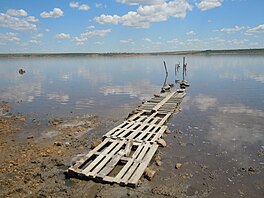| Kuialnyk Estuary | |
|---|---|
 The view of the estuary The view of the estuary | |
 | |
| Location | Ukraine |
| Coordinates | 46°38′N 30°43′E / 46.633°N 30.717°E / 46.633; 30.717 |
| Type | hypersaline estuary |
| Primary inflows | Velykyi Kuialnyk |
| Basin countries | Ukraine |
| Max. length | 28 km (17 mi) |
| Max. width | 3 km (1.9 mi) |
| Surface area | 56–60 km (22–23 sq mi) |
| Average depth | 3 m (9.8 ft) |
| Settlements | Odesa |
Kuialnyk Estuary (Ukrainian: Куяльницький лиман, Crimean Tatar: Kuyanlık), formerly known as Andriivskyi Lyman, is an estuary of the Velykyi Kuialnyk on the northwest coast of the Black Sea, one of the group of Odesa estuaries, located north of Odesa. The name comes from Crimean Tatar "kuyanlık," meaning thick.
General characteristics

The area, depending on the water level, ranges from 52–60 km². Its length is 28 km, and its width is more than 3 km. The average depth is about 1 m. The volume is about 52 million m³. It is separated from the sea by a sandy Kuyalnytsky-Khadzhibey peresyp sandbar up to 3 km wide. The Big Kuyalnik River flows into the estuary. The lowest point of Ukraine is located near the Kuialnytsia estuary: 5 meters below sea level.
On the southeast coast of the estuary there is the Kuialnytskyi mud resort, on the banks of the estuary - beaches. The water temperature reaches 28-30 °C in summer.
Once on the place of Kuialnytsia estuary was located the mouth of the river Big Kuialnyk. Over time, the mouth turned to the gulf of the Black Sea, and then due to the deposition of river and sea sand formed an overflow, and thus the gulf turned into an estuary. Separation from the sea took place in about the fourteenth century, much later than the branch located near the Khadzhybeian estuary. This can be judged at least by the fact that Kuialnyk's overflow is three times narrower than that of Khadzhybey.
The water level in the estuary and its salinity are regularly changed. Long-standing observations have shown that between 1878 and 1968 salinity in the estuary ranged from 29 to 269 ‰. During the years with high salinity, salt precipitated at the bottom of the estuary. In the dry years, when the Great Kuialnyk River dried up, the area of the reservoir decreased almost twice. Twice, in 1907 and 1925, seawater was launched to save the estuary from drying out.
See also
References
- Starushenko L.I., Bushuyev S.G. (2001) Prichernomorskiye limany Odeschiny i ih rybohoziaystvennoye znacheniye. Astroprint, Odesa, 151 pp. (in Russian)
- North-western Black Sea: biology and ecology, Eds.: Y.P. Zaitsev, B.G. Aleksandrov, G.G. Minicheva, Naukova Dumka, Kyiv, 2006, 701 pp.
This article about a location in Odesa Oblast is a stub. You can help Misplaced Pages by expanding it. |